| Welcome to 3T! Please take the time to register and join in on the friendly,knowledgeable watch talk.Please note that not all registrations will receive an immediate activation e-mail.Those who do not receive an immediate notification will be activated manually within 48hrs. by an admin. without an e-mail activation url sent to you,you may then sign in using your username and password,if you feel there is a problem please e-mail us at timetechtalk@hotmail.com and include your name and username and we activate your account.Thank You! |
| Moderated by: 3T |
|
||||||||||||||
| A closer look at the UN Freak...P.S Long Post... | Rating: 
|
| Author | Post |
|---|
| Posted: Fri Sep 14th, 2007 08:28 pm |
|
1st Post |
|
Hamilton 3T WIS
|
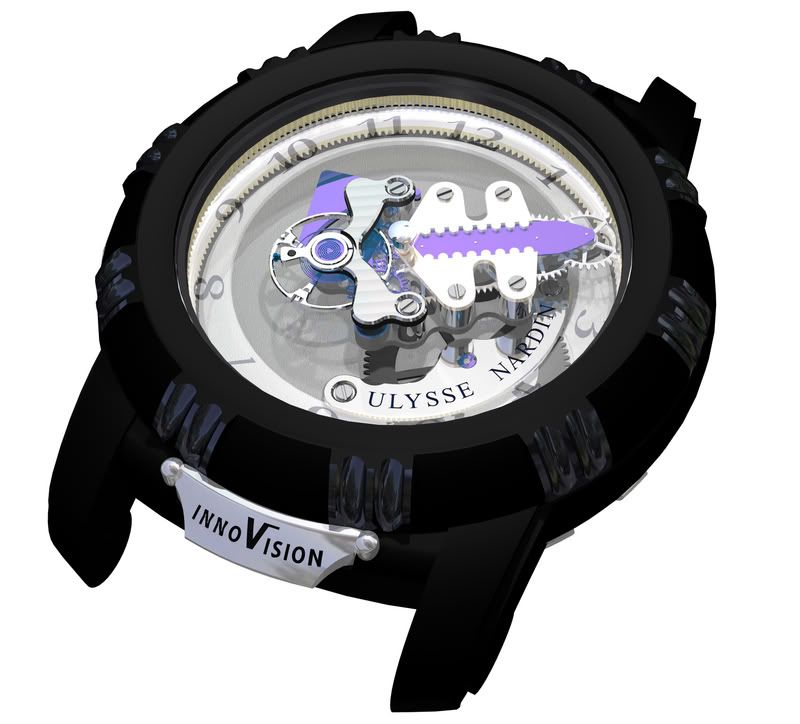 As the incredible Rolf Schnyder, owner of Ulysse Nardin unveiled his technical triumph the new innovision Freak, a watch with a movement that uses no lubrication of any kind and is not dependent on coating to achieve this put use the innate quality of silicium, I coulnd't help but here the refrain to Rick James seminal "Super Freak" reverberating in my head. OK all jokes aside wha Ulysse Nardin has done at the behest of Rolf Schnyder is nothing less than REVOLUTIONARY. A watch with a completely lubbrication free movement that incoporates all new manufaturing techniques never before used in watchmaking. Pierre Gygax UN's technical director states, "We really applaud the eforts made by other in particular Jaeger-LeCoultre in the pursuit of higher levels of mechnical performance for the watch with their extreme lab project. In particular the oscillator is something incredible. But for us we wanted to go an entirely different and new way by manufaturing a movement using technologies never used in watchmaking before at the material level" Says Schnyder, "When the Freak was launched in 2001 it expressed three revolutions, an aesthetic one, a mechanical one and a material one." Indeed was aesthetically and mechnically astounding the first act of modern art in high watchmaking. But today it is the material revolution of the Freak that is the subject of this article... Because the Innovision project is far more than a Super Freak, it is a project to consistently raise the bar on the performance on the mechanical watch to totally unprecedented levels! It meaningfully uses silicium for its elastic benefits, its non magnetic benefits, its ability to be crafted into super complex shapes and much much more... OK, flashback to the past...The curent InnoVision project is made possible by Ulysse Nardin's pioneering use of silicium in a wristwatch namely the Freak introduced in 2001. Because of the design of this watch's escapment that featured two escape wheels (the used the dual direct designed created by Ludwig Oechslin and inspired by Breguet's "natural escapement" ) UN was forced to search for an alternative material that was far lighter than gold or steel. They initial tried aluminum but this got chewed up after a while because of the amount of pressure placed on the 5 impulse teeth of these wheels. To give you a contrast the escape wheel in a tradtional Swiss anchor escapement has 20 teeth so the force is distributed over a greater number of teeth. UN ater addressed this when they went to the Dual Ulysse escapement which has 18 teeth and is featured in all the Freak II's the Caliber 160 movement and of course the new Innovision Freak. It was Pierre Gygax Rolf Schnyder's dynamic techical director that had first heard of silicium from Michel Vermot. Mr. Vermot worked at the time at the Ecole d,Ingenieur in Le Locle, approached the IMT-CSEM to make in the middle nineties or abouts an escapement in Silicium. Gygax had heard of silicium being used for its conductive properties in computers but never for its elastic properties. However doing more research he found that the DRIE technique used to create micro componenets let him make tiny parts to incredible tolerances. Now the first silicium wheels created for intial Freak's had a DLC coating on them and it was at the time hard to control the consistenty of this coating process. It was particualry difficult to inspect the vertical walls of componenets. Wheels that where the coating was perfect ran perfectly, wheels with coatings that were slightly imperfect, in concert with the high stress placed on their teeth because of the Dual Direct's design could run less well particulalry if a bit of dust happened to settle on the side walls. Says Gygax, "This coating was proposed to us by the CSEM but in retrospect those wheels with good coating ran better than bare silicium would have and those with not good coating ran worse." This is the reason that UN has undergone the admirable process of taking back any Freak's not working perfectly and retrofitting them with high quality wheels and in some cases, the new escapement. Says Pierre Gygax, "As the first ones that try anything new, you also take all the responsibility for risks but I must say that if we didn't try silicium in a watch I don't think anyone would have. Today the wheels and all components are of incredible quality with geometric tolerances of 1 micron and bore tolerances of 2 microns." It was because of the vast poetential for siliicum a material that was non magnetic, needed no lubrication and could be crafted into a myriad shapes that UN created SIGATEC a joint venture with Mimotec to create siliicum components for the watch that includes a vast array of applications including MINUTE REPEATER RACKS. These racks feature special slotted teeth that allow them to have a perfect fit against other teeth. This technology could well end the dreaded chronograph backlash in laterally coupled chronographs because of the innate flexibility of the teeth but that's another story... Sigatec specializes in the creation of silicium componentry and is a joint venture between UN and Mimotec. The founder of Mimotec is Dr. Hubert Lorenz who managed to created a LIGA - photolithography process that didn't use X Ray but used UV rays instead. The CEO of Sigatec is Andre Glassey With Sigatec, Ulysse Nardin has created a vast array of componenets including a silicium hairpsring (which is coated with silicium oxide to compensate for changes in elasticity during thermal varation!) and BI MATERIAL components. THATS RIGHT WE ARE TALKING ABOUT ESCAPEWHEELS WITH SILICIUM TEETH AND A NICKEL PINION BUT MADE AS A MONOBLOCK PIECE. The silicium piece is first created and then nickel is grown directly onto it. Further all silicium parts are treated to a silicium oxidation process by being exposed to heat. This causes the formation of a layer on silicium oxide on the surfaces which pnentrates 30 percent down into the material to as Gygax says, "fill any valleys in the material created during the etching proces." The result is pieces that are of perfectly smooth form with vertical sidewalls and theoretcially should not be affected by temperature compensation.  CHECK OUT THE AWESOME 10 INNOVATIONS IN THE INNOVISION WATCH!!! Innovation 1 - Barrel on ball bearings. A 96 balls, non lubricated ball bearing guides the barrel both vertically and laterally. This solution is on the market since 2005. 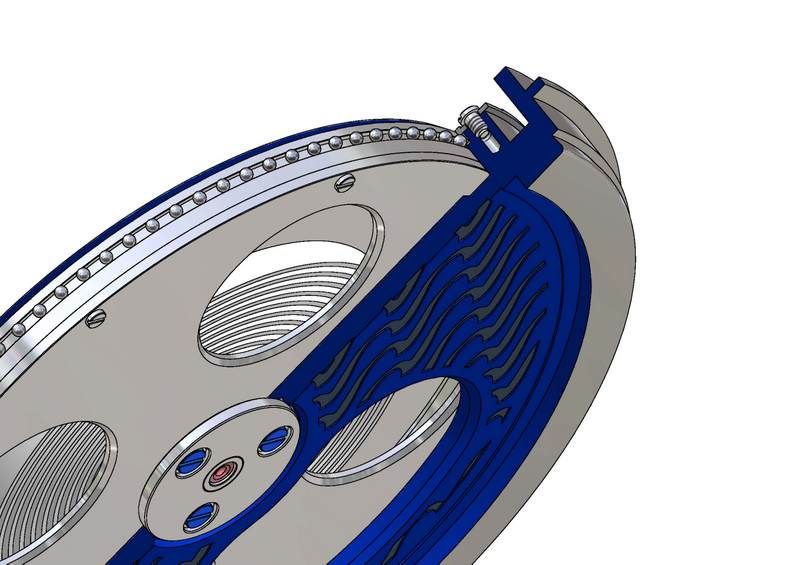 Innovation 2 - “Dual Ulysse” escapement. The “Dual Ulysse” escapement does not need any lubrication. Its reduced angle of lift (31 degrees) provides a great advantage. It is on the market since 2005.  Innovation 3 - Silicium bearings. Lubrication free bearings in silicium are fitted into the brass base plate. No oil recesses are necessary. 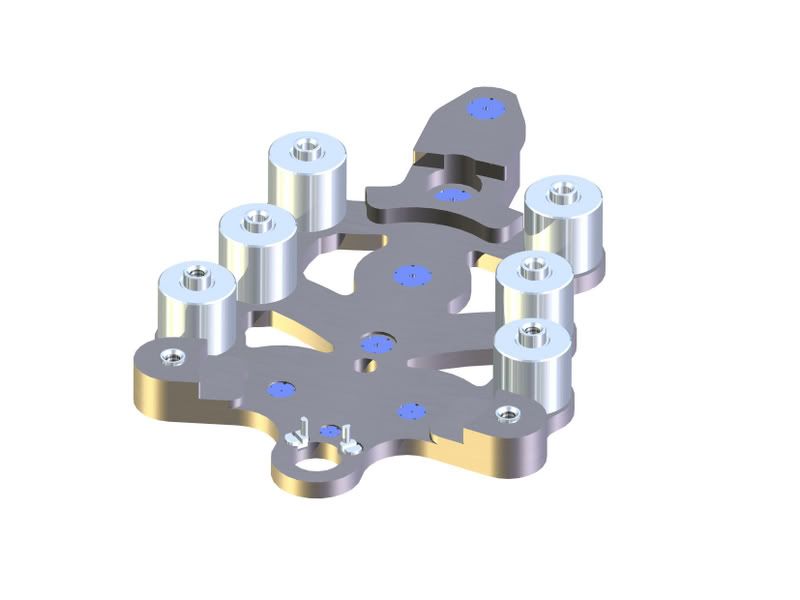 Innovation 4 - DRIE precision and low friction advantages put together. The escapement bridge made in solid silicium benefits from the high precision of the process. The good friction coefficient of silicium is another advantage. The movement designer is free to design holes very close to the exterior of the bridge as no jewels are required. 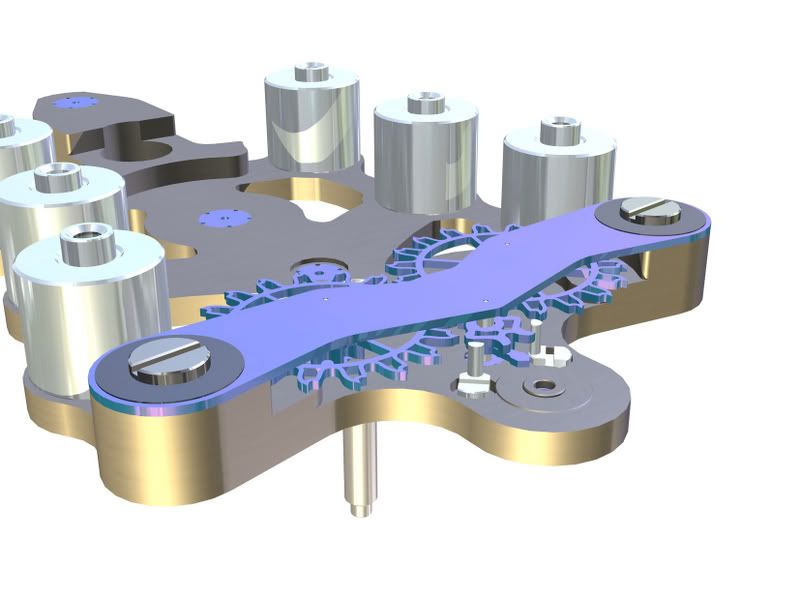 Innovation 5 - The reinforced silicium bridge. Due to the combination of 2 technologies DRIE and LIGA, Sigatec, Mimotec and Ulysse Nardin have produced a bi-material bridge which performs extremely well.  The exclusive process stands for precision, silicium stands for low friction and nickel stands for mechanical toughness. Innovation 6 - Exploiting the elasticity of silicium. Ulysse Nardin developed the revolutionary shock absorber bearing into the balance wheel shaft which pivots in the centre of the silicium disc. The elastic spiral shaped silicium disc deforms itself when shocks arise and returns to its original position immediately after the shock has been absorbed. 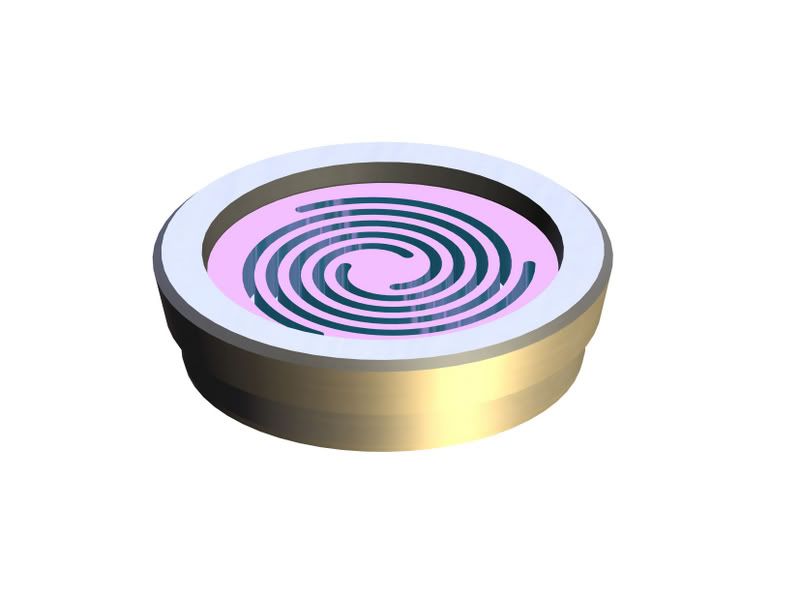 The spring, endstone and bearing is just one elastic unit that deforms and returns to shape to absorb shock. Innovation 7 - Silicium spring. The Silicium hairspring is an excellent solution and we have the know-how to produce it.  Innovation 8 - Roller and Pin. The roller and pin are made in one precise single component in the double sided DRIE process developed by Sigatec. [img]http://i131.photobucket.com/albums/p291/revolution-press/Innovation8_Roller_and_pin.jpg Innovation 9 - Stopper fork and security pin of the “Dual Ulysse” escapement. The” Dual Ulysse” escapement « blocker » is a multifunctional element. Similarly to the anchor of the Swiss Anchor escapement, it bares a safety-pin which must be perfectly aligned. 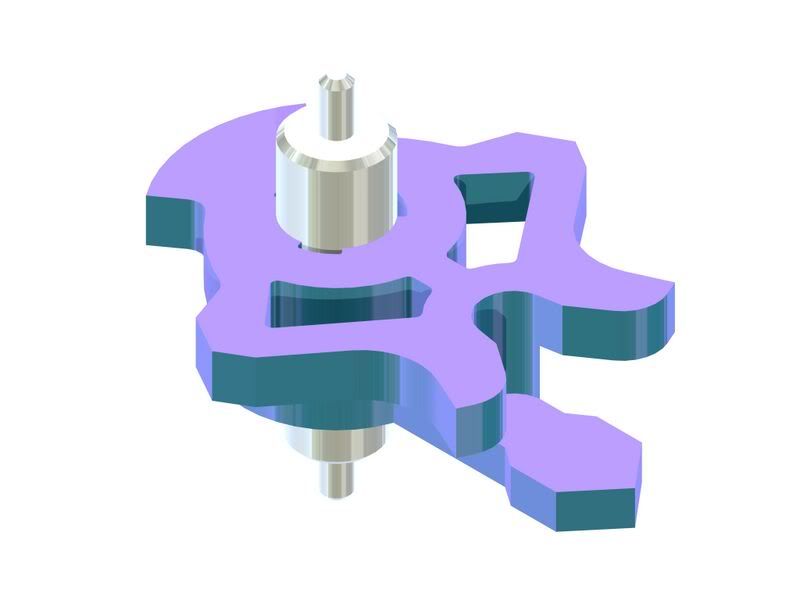 The double side etching process created by Sigatec. This former multi part unit can be made as a single component not requiring any assembly or touch up. Innovation 10 - Two level process. The escapement wheel and pinion are made in one single piece thanks to the two level etching process created by Sigatec. This new technology will seduce many movement designers all over the world. Pioneering. 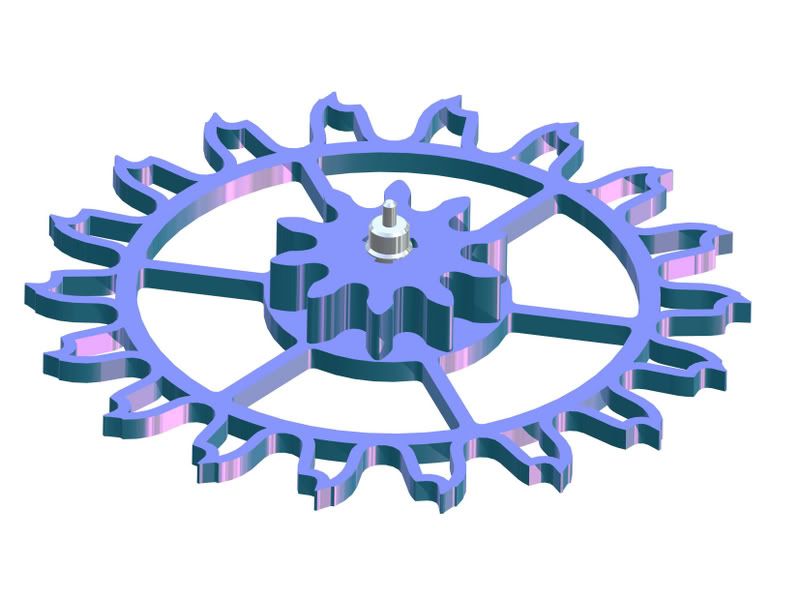 Ulysse Nardin has presented quite a number of “World’s Firsts“ in the past years, and many of them have used the „Freak“ as a showcase. The “Freak“ was the first watch with a silicon escapement. It was commercialized in 2001. Some Freak prototypes housed the first hairspring made of polycrystalline diamond which showed astonishing elasticity. The “Dual Ulysse” escapement with parts made of nickel-phosphor (NiP) and silicium (2005) The first watch with an escapement made of polycrystalline diamond was commercialized in 2005 Escapement components made of silicium can be used as skeletons to “grow” on them polycrystalline diamonds The succession of “Freak” models illustrates the continuous technological developments at Ulysse Nardin! 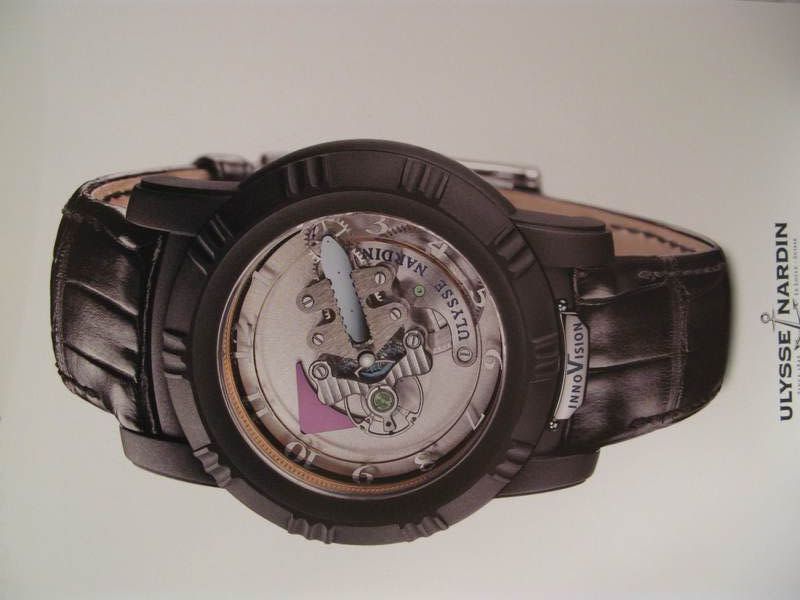 An in-house manufactured balance wheel that is featured on current freak's and on watches using the Caliber 160 in-house movement with the Dual Ulysse Escapement. 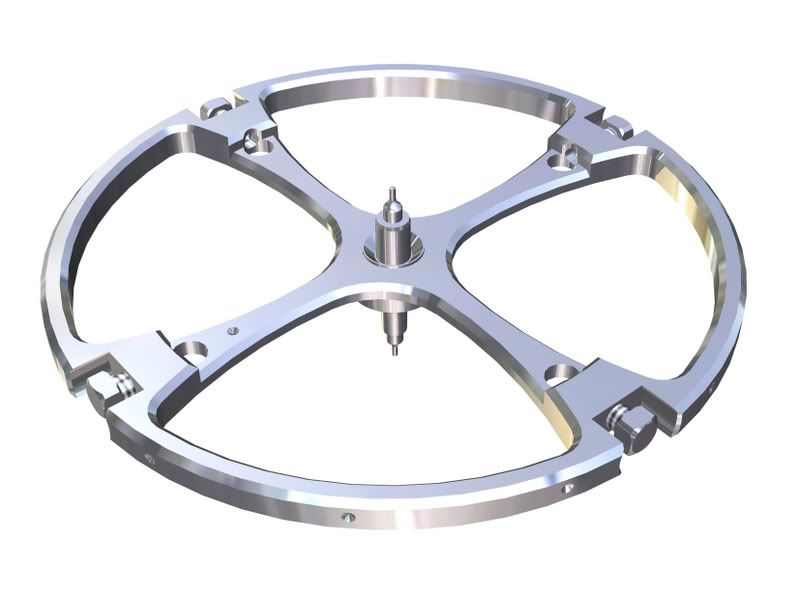 SADLY THE INNOVISION FREAK WILL NOT BE OFFERED FOR SALE AND HAS BEEN CREATED PURELY AS A TEST PLATFORM FOR NEW TECHNOLOGY!!! What can we say, Please Rolf release it for sale!!!! ULYSSE NARDIN?S FREAK ? WATCHMAKING?S FIRST ACT OF MODERN ART   Launched at the 2001 Basel Fair, the Freak sparked a revolution in watchmaking and stands alone as the single most significant modern watch of the last 100 years. The Freak exploded human perceptions of what a wristwatch should be. It was a watch with no crown and no hands, where the constantly revolving movement gave the indications for time. Fusing the lyrical turbulence of mobile sculpture and the visual audacity of installation art the Freak gave birth to the modernist aesthetic in watchmaking. Like the first broken chord of jazz ever played Schnyder transcended the rules by rewriting them. The Freak synthesized the Bauhaus love for machine age functionalism with haute de gamme watchmaking. With each beat of life that emanated from its twin silicon wheel escapement, the Freak reminded us that our innate fascination for timepieces results from the human creativity and artistic vision they represent. A WATCH WITHOUT HANDS? What is the Freak? It is a watch with no crown and no hands. The entire movement is driven by the mainspring and rotates in such a way that the movement is the instrument for telling time. The hour indicator is found on the mainspring barrel, while a lithe escapement bridge acts as the minute indicator. Says Rolf Schnyder I like to think of the Freak like the work of the Swiss kinetic sculptor Tinguely, it is poetry for the wrist.? The Freak is the first watch to truly celebrate its movement, placing it on a rotating pedestal and open it up the world. In an act of intellectual inversion the barrel replaces the overt opulence of the heavily guilloche dial and the ethereal gold escape bridge replaces mundane watch hand. The Freak was the first of its kind and his paved the way for the three dimensional interpretations of time that are grabbing headlines today. Why call it the Freak? The name began as the secret code word for this project. Says Rolf Schnyder, ?I remember Dr. Henry Tay (of Singapore?s the Hour Glass) having some real reservations about the name. He said ?How can you call such an elegant watch ?the Freak??? But in the end the name stuck because of the way the timepiece smashed every convention known to watchmaking in its own inexorably freaky way. What was the exact moment the project was born? Ludwig Oechslin remembers the fateful day he got a call from Rolf Schnyder asking him to take a look a problematic carousel tourbillon project (this was done by the brilliant Carole Forestier-Kasapi who is the head of complicated movements at Cartier and is the genius behind Piaget's Tourbillon Relatif). Says Forestier-Kasapi who won a Breguet Award for tourbillon design "The main innovation was in the cage carrying not only the balance wheel and the escapement, but also the whole train of gears of the watch. The cage is set in the center of the watch and rotates once every hour inside the barrel." Little did Oechslin know together they were about to embark on a project that would forever change the face of watchmaking. Ludwig explains, ?Rolf showed me the plans for this watch were the movement was inside the center of the mainspring. The mainspring caused the entire movement to rotate. But the problem with this design was that with the mainspring occupying the space between the movement and the case there was not enough power to drive the watch.? Rolf tells us, ?The problem with this movement was we just couldn?t get more than eight hours of power reserve from it. It was impossible to create a mainspring big enough to be functional in this. I explained to the watchmaker who designed it that I wanted to show it to Ludwig and have him make some suggestions.? The truth was that the situation was tenuous. Ulysse Nardin has already invested in this project and now it looked impossible to achieve. But as Ludwig Oechslin studied it, something started to take shape in his mind. Says Pierre Gygax, ?What makes Ludwig very special is his ability to see very simple pure solutions to complex problems. In this situation what he came up with took us in a totally new direction.? ?I new that Ulysse Nardin had invested heavily in this other project but it also became clear to me that it simply could not work. At the same time what I kept wondering was this,? says Ludwig. ?Why make all the mathematical calculations to make a movement that rotated inside the watchcase at 58 or 59 minutes per revolution. Why not make the movement complete one full rotation every 60 minutes because then you have an indication!? 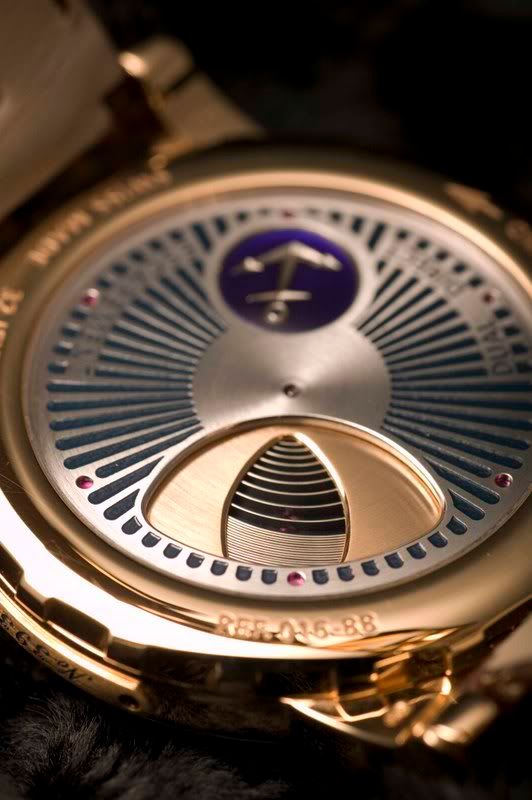 Here you can see how the mainspring of the Freak occupies the entire bottow layer of the watch. To wind it you turn the flange on the watchback. 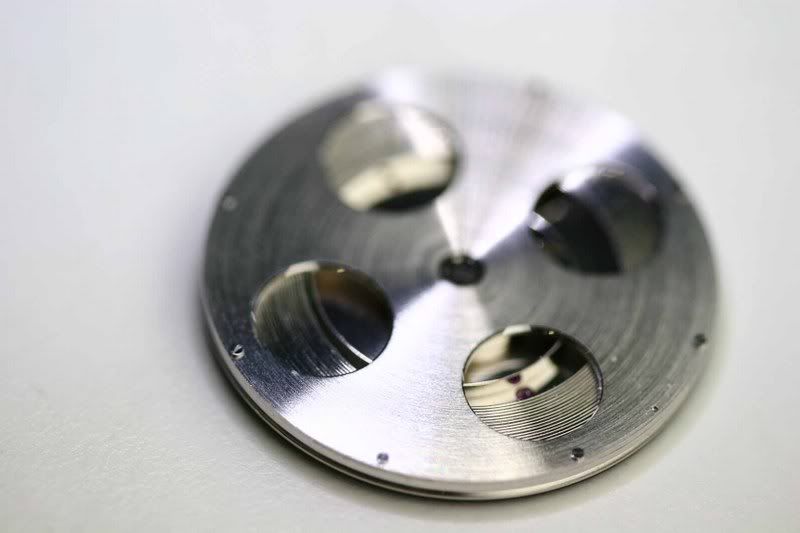 To solve the power reserve issue Ludwig immediately transplanted the mainspring from to a layer just beneath the movement. Then his mathematical ability came into play. By recalculating the gearing of the mechanism he arrived at way to have the movement complete a full rotation once every 60 minutes giving him his minute indicator. From there logic dictated that he create a second indication on the watch barrel that completed a full rotation once every 12 hours. The hours were read from an indicator fixed to the mainspring barrel while the minutes were told from an indicator fixed to the escapement bridge. Says Rolf Schnyder, ?The beauty of this idea was the purity of is design. There is a poetic economy to a watch that doesn?t need hands because the movement gives you the indication of time.? While all watches tell time thanks to their movements, only in the Freak does the movement itself tells you time! AN ALL NEW ESCAPEMENT As revolutionary as the design of the Freak already was, one additional mind blowing innovation was soon to be added. Ludwig Oechslin?s Dual Direct escapement transformed the Freak from already incredible work of art to a timepiece that has irrevocably changed the face of modern watchmaking. Before the Freak this escapement existed only inside an antique carriage clock owned by Ludwig. He explains, ?The clock had a very bad escapement so when I removed it and replaced it with the first prototype of my Dual Direct escapement using gear based escape wheels.? Ludwig had been trying to convince Rolf Schnyder to use this escapement for several years. Says Schnyder, ?I remember the first time he came into my office looking very proud. He placed this clock on my desk. I asked him ?yes what can I do for you?? And he said, ?But look! Look inside at the escapement.? It was very impressive but the escapement is the one part of the watch that we?ve never had a problem with. We?ve never had any watch come back for service because of the anchor escapement. Also in a normal wristwatch can?t really see the escapement anyway. So I decided not to use it at the time. He looked really depressed after this. It was Pierre (Gygax) who became really excited and began to experiment with different materials for the escape wheels so it could become implemented in a wristwatch.?  In the Freak the escapement is right on top of the whole watch, it?s the first thing you see and it?s what gives you the minute indication. But when the Freak project began to take shape, Rolf Schnyder saw the potential of Ludwig?s new escapement design. He explains, ?In the Freak the escapement is right on top of the whole watch, it?s the first thing you see and it?s what gives you the minute indication. I thought, OK in this watch we can put this new escapement.? But as the 2001 Basel Show drew near pressure mounted. Says Rolf, ?At one point I almost told them look if you can?t sort out the Dual Direct then we will just put a Swiss lever escapement in it. But I have to give it to Pierre he really delivered.? Says Pierre Gygax, ?We would not have introduced the new escapement in a normal watch, but when Ludwig came up with idea for the Freak, we knew this is the opportunity! To have such an extraordinary visual showcase for this incredible new escapement couldn?t have been more perfect!? HOW DOES IT WORK One of the most impressive aspects of the Freak is the simplicity, logic and mechanical purity of its design. The Japanese art of Haiku uses the barest minimum of words to communicate an emotion. Similarly the Freak, a watch that uses parts of its movement for time telling indicators is an example of minimalist thinking at its best. In structure the Freak is a carousel tourbillon with a 7 day power reserve. A carousel tourbillon differs from a traditional tourbillon in that while the classic tourbillon the escapement rotates around the central axis of the balance wheel once every minute, in a carousel tourbillon the balance wheel is not in alignment with the central rotating axis. Think of the Merry-Go-Rounds you used to ride as a child. Now remove the wooden horse at the perimeter of the ride and replace it with a watch?s balance wheel and you have a carousel tourbillon - where the regulating organism rides offset from the platform?s central rotating axis. The movement of the Freak is constructed like a three layer cake. The base layer consists of the watch?s massive main spring. Flip the Freak over and feel your pulse quicken as you stare at the muscular potential of the mainspring. The Freak boasts the largest mainspring in existence today. This coiled behemoth spans across the entire case diameter and feeds enough energy to continually drive the rotation of the entire watch movement for 7 days. To feed this goliath power you turn the case back counter-clockwise and a pinion inside the mainspring barrel is picked up the by rotating arms attached to the case back. Fourteen turns of the bezel are enough to provide full energy to this mighty power supply. You can tell when your spring is fully wound when the its coils are densely packed to the center of a barrel like a cobra poised to strike. The second layer consists of the watch?s blue barrel drum. This flat wide barrel contains the awesome power of the life giving mainspring. It is important to mention here that with the Freak all life begins with the mainspring of the watch. As it uncoils it causes the hour wheel to turn anti-clockwise against a track at the perimeter of the movement. This wheel?s arbor is carried by the barrel-drum causing the entire barrel assembly to turn in a clockwise direction. Through an alchemic calculation of mainspring torque related to the number of teeth in both the hour wheel and the track it rides in, the barrel completes one full rotation in precisely 12 hours. As such a gold arrow is fixed to the barrel and becomes the watch?s hour indicator. The distinctive blue hour wheel drives the watch?s center pinion which then transmits the mainspring?s energy to the wheels of the gear train found on the third layer of the Freak. 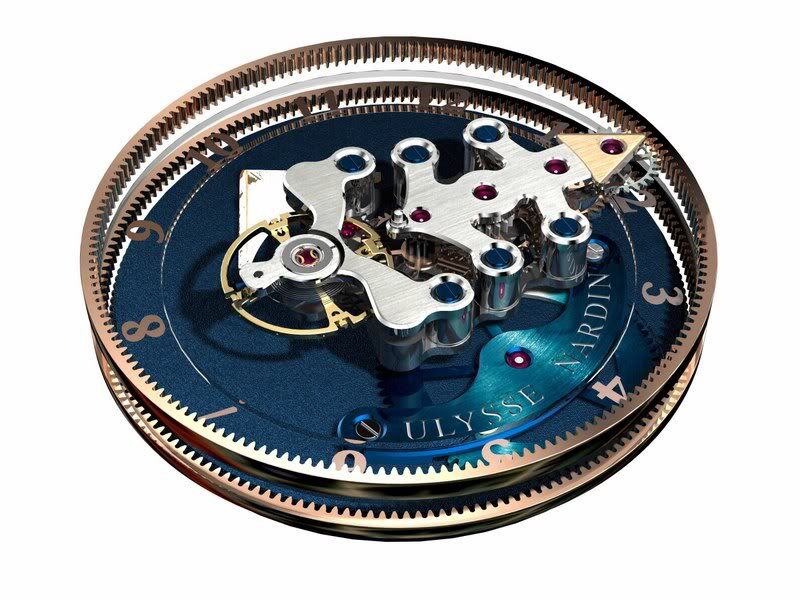 Here you can see the top 2 layers of the Freak, the barrel cover carring the hour hand and the escape bridge that also acts as the minute hand. The third layer consists of the carousel tourbillon movement assembled into the watch?s center pinion. The entire movement is contained within a stylized arrow shaped bridge that is milled then spark eroded to define its complex inner angles before it is painstakingly hand finished. On one side of the bridge is the watch?s free sprung balance driven by Ulysse Nardin?s signature Dual Ulysse oil free escape wheels. The gear train runs across the bridge from the escapement to the first wheel that rolls on a fixed track placed at the perimeter of the movement. It is on this bridge that all the visual pyrotechnics occur igniting a miniature mechanical universe known to draw owner?s into a hypnotic reverie. Here?s how it works? Energy given by the hour wheel to the center pinion flows along the escapement bridge. The locking and unlocking of the escape wheels set the tempo of the uncoiling of the mainspring. The mainspring provides the energy as the balance swings back and forth essentially opening and shutting the tap (the escapement) to regulate the power flow. Now here is exactly how power in the Freak flows from the mainspring to the balance wheel. Power goes from the barrel to the blue hour wheel. From the blue hour wheel power is transmitted to the central pinion which consists of the lower end of the main central shaft and has teeth. It is important to note that the blue hour wheel?s teeth mesh with the teeth of the outer track as well as with the central pinion teeth. Power then flows from the central pinion towards the first wheel by mean of the upper fixed track. This happens because the base plate of the escape bridge is rigidly fixed on the central pinion, so that when the pinion turns under the drive of the blue wheel, the base plate has to turn together with the central pinion. The first wheel which is geared in the upper fix track ?recuperates? or gathers the energy from the fixed track. 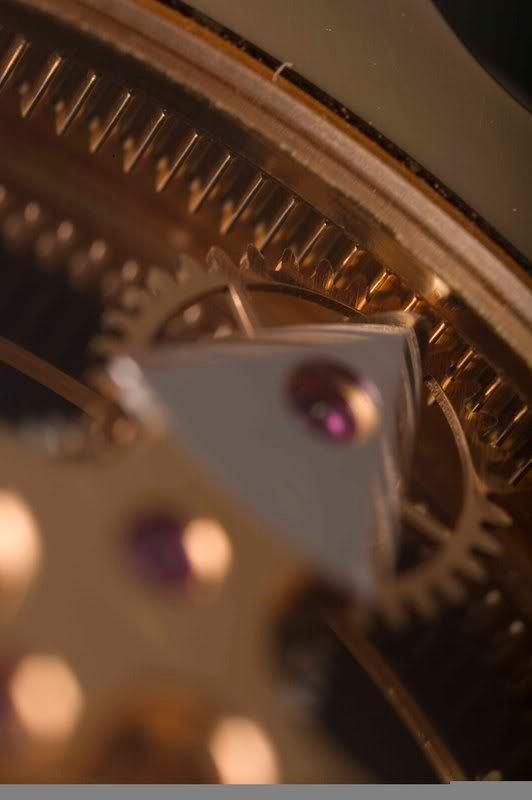 You can see here that the first wheel is geared in the upper fixed track. If this sounds confusing a good analogy is this: The engine of a car provides energy to the wheels. The tires ?recuperate? the energy from the fixed road and convey this energy to the carriage which goes forward. The first wheel recuperates the energy of the mainspring from the fixed track and sends this energy across the escape bridge towards the escape wheels which are constantly under pressure. Finally energy is sent from the escape wheels towards the oscillating balance passing through the alternator. 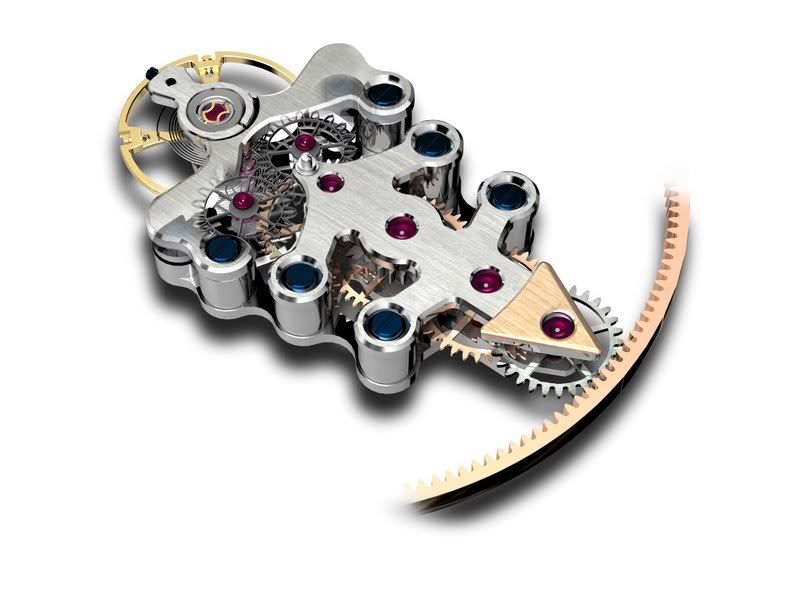 Energy travels across the escape bridge to the balance via the dual escape wheels. The oscillating balance looses a small amount of energy when it unlocks the escapement to trigger the impulse it is going to receive. This energy never flows further. Fixed directly above the first wheel is a gold arrow that is the watch?s minute indicator. 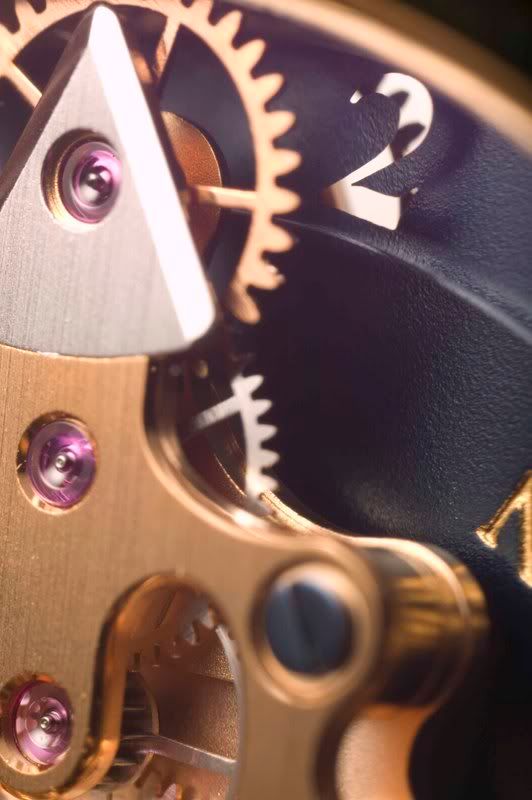 Here you can see the pane of sapphire that is placed between the barrel and the escape bridge and that carries the Arabic hour indices Sandwiched in between the second and third layer of the Freak is a pane of sapphire that the carries the watch?s Arabic hour indices. These are placed here so that that they will have equal proximity from the gold hour indicator that rotates on the barrel cover beneath and the gold minute indicator that hovers above it. By turning the bezel you can set the time on the Freak. To understand how time setting takes place in this incredible timepiece we need to further elaborate on the movement?s basic construction. The central shaft of the Freak consists of 3 sections which are fixed together and act as 1 single part. The lowest section of the shaft consists of the central pinion and the pivot which turns freely into the lower jewel that you can see from the back of the watch. This jewel is easy to spot as it is fixed with three blued screws. The middle section of the shaft consists of the base plate and the escapement bridge. If the shaft were one single rod from bottom to top, the Freak?s wheels could not turn as they would collide against the rod. The upper section of the shaft consists in the shaft end pivoting freely into the upper jewels hidden inside the golden ?chatton? that you can see in the middle of the watch?s sapphire crystal. When you set the time by rotating the betel this is what happens: The bezel brings the upper fixed track with it. That?s right? the upper fixed track is attached to the bezel. It is fixed when you do not set the time. But turns with the bezel when you do. When time setting, the bezel and track turns together. The teeth of the first wheel are geared in the teeth of the track. When you turn the bezel clockwise, the first wheel turns counter clockwise against the teeth of the track and the whole ?escapement bridge/minute hand? turns clockwise. The difficulty in creating a watch with this configuration is that it supremely vital to obtain a very straight and centred shaft although this component is in fact made in 3 sections. To accomplish this you must perfectly line up the movement?s bearings although the 2 bearings are set in the 2 furthest extremes the case. Because the Freak essentially consists of a movement that turns as the mainspring uncoils, setting the time has a minor effect on the power reserve. When you set the time forwards you are uncoiling the mainspring and you will lose one hour for each full rotation of the bezel. When you set the time backwards you are coiling the mainspring and gain one hour of power reserve with each full rotation of the bezel. Since the total power reserve of the Freak is 7 days the setting of time in either direction has a little effect on overall power reserve and cannot damage the Freak even when setting time on a fully wound watch backwards. When asked the biggest challenge in the assembly of the Freak, Pierre Gygax explains that mounting the movement inside the case takes immense precision. ?The Freak essentially is a house built on two pinions. On the top you have the pinion that runs from the escapement bridge to the sapphire crystal and on the back you have a pinion that runs from the barrel to the watch back. It is critical that during final assembly these two pinions are perfectly aligned with one another, because otherwise when we place pressure on the movement as we case it, these pinions can become off center.? Rolf Schnyder adds, ?There are so many people that would love to have a Freak but we have a hard time meeting the demand. The Freak is rare simply because there are not many watchmakers skilled enough to make it. This final assembly takes incredible ability achieve correctly but once it is done properly you have a watch that is extremely stable.? 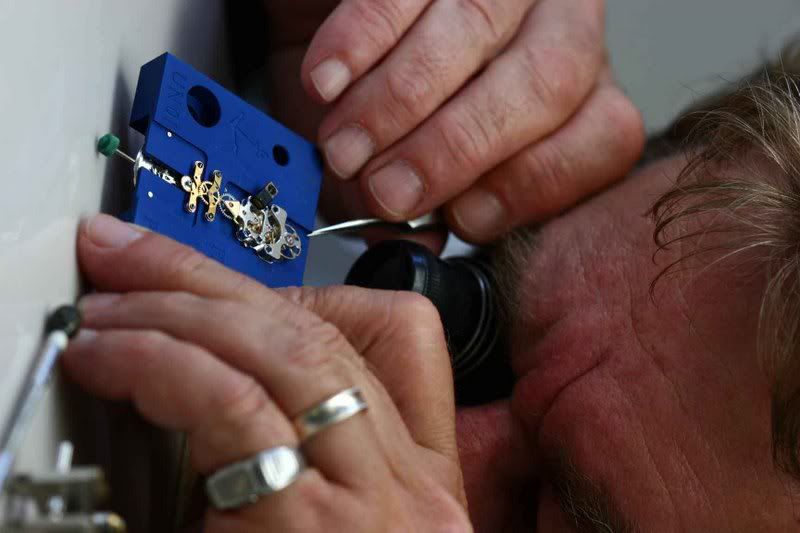 Here a watchmaker adjusts the escapement and regulates the balance of a Freak even before it is placed on top of the central pinion In addition to this detail, the Freak presents other challenges to watchmakers. It must perfectly regulated before being cased because to open it to reset the inertia screws of the balance wheel compromises all the careful work to case it perfectly. As such every Freak escapement is regulated onto a special tool that provides power to the center pinion so that the balance can be perfectly poised before it is cased. The Freak was introduced with true visual panache at a ?Basel Carnival? inspired fete three weeks before the 2001 Basel Watch Fair. During this event a troupe of drummers and piccolo players all wearing masks of Dr. Ludwig Oechslin and conducted by a particularly authoritative figure wearing a mask of Rolf Schnyder as well as a mask of Ludwig Oechslin. After a dramatic drum roll and the curtain was raised on this mind blowing timepiece. As the crowd cheered one piccolo player unmasked himself and revealed himself as Ludwig Oechslin. Finally the conductor unmasked himself and was revealed to be Rolf Schnyder. His speech on ?Poetry in Watchmaking? aptly expressed the incredible achievement of the Freak. The Freak has gone on to win numerous industry awards, delighted hundreds of lucky owners and has even won fans amongst the watch industry elite. Karl Friedrich Scheufele Co-President of Chopard declared it the watch he would most like to own. Says Ludwig Oechslin, ?I think the Freak is the first watch that was made outside of the tradition of watchmaking in the last 100 years. It was the first watch to open up the invisible world of the movement to the owner. It is something totally different and I have to say I admire Ulysse Nardin for taking a chance with it because it takes really courage to be really innovative. It also liberated the industry, it gave us freedom and gave birth to this idea of concept watches that are as much interpretive art ads they are time telling machines. I doubt very much that there would have been a Tag Heuer V 4 or any other concept watches were in not for he Freak.? Looking back at the past half a decade the impact of the Freak has been enormous. It can be said that the Freak was the first flashpoint of inspiration that opened the doors to a world of modern watchmaking where time is told through three dimensional indicators. There could never be a Harry Winston Opus V or Bugatti watch without the advent of the Freak yet the Freak still stands apart from these other modernist timepieces in that while these watches add complications to tell time creatively, the Freak strips time telling down to its barest poetic simplicity. And it is for this reason that it has written its own permanent chapter in the history of horology. EVOLUTION OF THE FREAK Such is Ulysse Nardin?s commitment to providing the best quality products to the market that even with a watch as innovative as the Freak, constant measures taken to improve overall reliability and ease of use. Already the Freak stands out as one of the most under priced high complications in the watch market considering the immense research and development undertaken to realize it. Says Ludwig Oechslin ?There?s a reason why manufacture?s rarely step outside of the box and create something new from the ground up and that is because it cost so much money.? When asked if he knew this going into the project, Rolf Schnyder replies, ?Of course, but someone had to be the first to do something different, and to try to make something better.? In the short five years since its inception three versions of the Freak have been born. The first is the original version that uses Ludwig Oechslin?s ground breaking Dual Direct escapement. As detailed in the chapter ?The Heart That Ticks? the challenge in industrializing this incredible invention was finding a light but hard material for the watch?s twin escape wheels. Ulysse Nardin found the solution in Silicium a mineral that was etched out using photolithography. 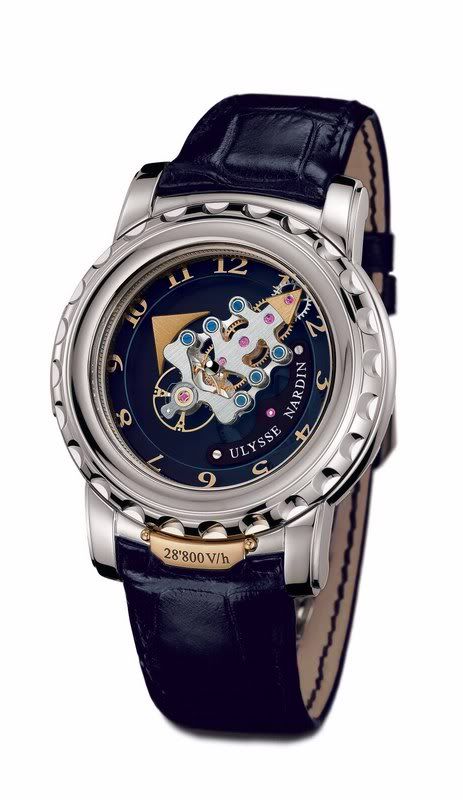 The Freak 2 has a new escapement (now also found in the Caliber 160) called the Dual Indirect or Dual Ulysse. 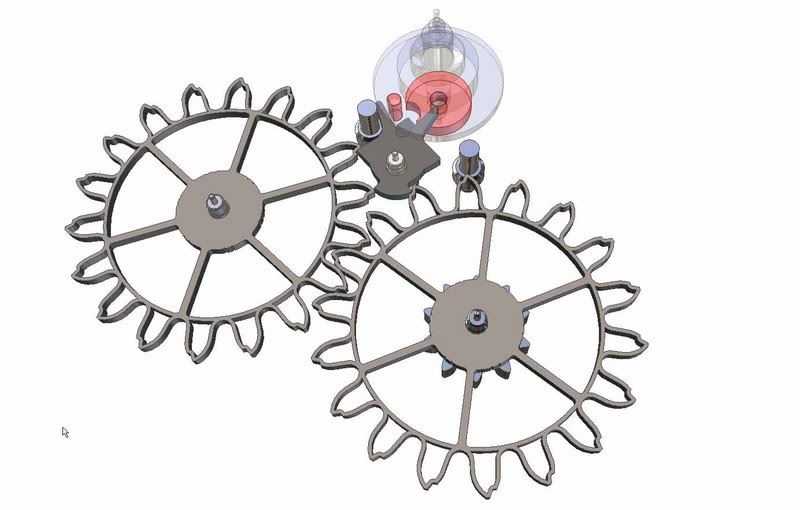 The Dual Ulysse or Dual Indirect strikes an alternator which gives an impulse to the balance via the impulse pin. In the Dual Direct the the teeth of the escape wheels would directly impulse the balance via the impulse pin. 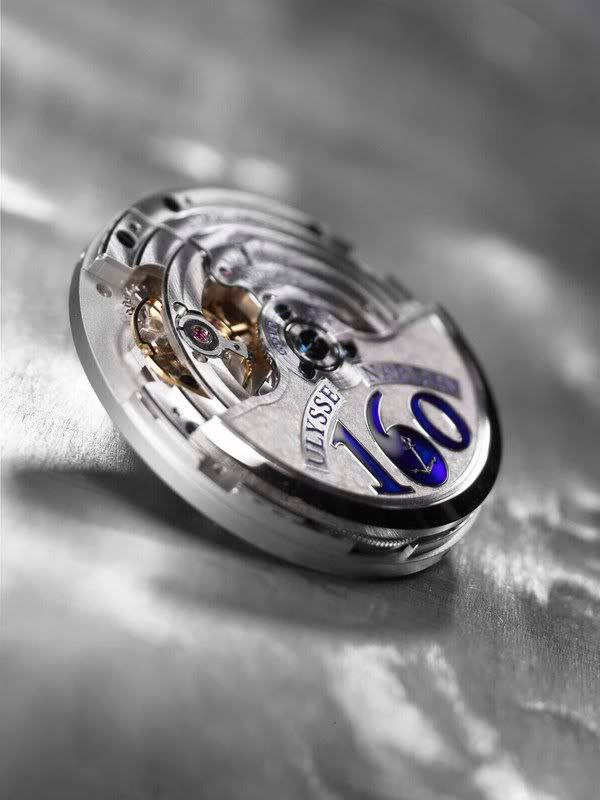 The Caliber 160 uses the Dual Indirect escapement The Freak 28,800 or the ?Freak 2? as it has been dubbed by collectors is immediately identified by its leaner, more aggressively attenuated escapement bridge. Beating on this bridge is Ulysse Nardin?s new innovation the Dual Ulysse or Dual Indirect escapement. The main difference between the two escapements is this. With the Dual Direct energy was transmitted directly (hence the name Dual Direct) from the impulse teeth of the escape wheels to the impulse pin of the balance wheel. Wheels were locked in position between each swing of the balance wheel using a small stopper that was activated by the balance?s impulse pin. In this model the impulse to the balance was given every by every fifth tooth of the wheels or at every 36 degree rotation of these wheels. The impulse teeth contact the impulse pin of the balance after it completes a swing of 52 degree of ?lift angle.? The balance wheel oscillates at 3 Hertz or 21,600 beats per hour. In the Dual Ulysse Escapement energy is fed indirectly (hence the name Dual Indirect) to the impulse pin using an alternator. The alternator contacts the impulse pin and it curved profile allows for better accuracy in engagement. The two escape wheels drive the alternator. The tip of each tooth features a small detent that is caught and locked against the upper edge of the alternator. The impulse pin of the balance frees the alternator as it descends after each swing. The major difference between the Dual Direct and Dual Ulysse is that in the later, the impulse is given with every tooth. This translates into wheels that feed energy to the regulating organ every 10 degrees of their rotation and allows Ulysse Nardin to utilize a revolutionary narrow lift angle of only 27 degrees between each contact of the impulse pin. This shorter and more frequent arc translates into a watch that beats faster at 28,800 vibrations per hour and offers excellent stability yet maintains the watch?s one week power reserve. The escape wheels in the Freak 28,800 are made from nickel phosphorous rather than Silicium. Advances in LIGA technology; a combination of photolithography and electroplating, creates nickel based micro components with incredible precision. In addition to changes to the escapement the new Freak 28,800 features a bezel lock has been placed at 6 o? clock to the bezel. By lifting this you unlock the bezel to set the time and by pressing it close you lock the bezel in place. When asked why this additional locking device had been made to a bezel that is by all accounts resistant to accidentally turning, Pierre Gygax explains, ?At Ulysse Nardin we are always looking for ways to improve our watches. Often times this comes down to small details. We had a few comments about accidental turning of the bezel. It is very hard to adjust the tension of the bezel because the entire bezel assembly rotates on top of a gasket to seal out dust and other elements. The nature of gaskets is such that in very cold weather they will contract slightly and in warm humid weather they will expand. So it is possible that people wearing the Freak in very cold weather might find there is less tension on their bezel. As such we devised the bezel lock as a simple but effective solution to accidental turning which would result in changing the time.? It is amusing to note that the manufacture stresses that the Freak is a dress watch ?not suited to withstand the extensive shocks of tennis, golf etc.? Pierre wears a Freak diamond heart on his wrists while skiing and during other rigorous sports. So far he has found his watch to be extremely stable a nod to the architectural excellence of the Freak?s design. The latest incarnation of the Freak is called the Diamond Heart. Don?t be misled, the name is not a reference to the rows of flawless diamonds that blaze off the case like a bank of paparazzi flash bulbs, nor is it a nod to the diamond set hour and minute indicators or even the engraved pattern of diamonds that decorates the top bridge. The Diamond Heart uses the manufacture?s signature Dual Ulysse escapement with one massively important difference. Look at the escape wheels - rather than the dark shimmer of nickel phosphorous - you?ll see a pair of near transparent wheels crafted from diamond. Pierre Gygax explains, ?The difference and cost between the diamond wheels and nickel wheels is easily 1000: 1. Not only is the raw material more costly the manufacturing process is much slower and more time consuming. But the advantage is that diamond is the optimal material for escapements.? Rolf Schnyder explains, ?Diamond is anti-magnetic, needs no lubrication and lasts forever. The only barrier with diamond is the extremely high cost.? Another testament to the manufacture?s remarkable intelligence is Ulysse Nardin?s status as the world?s first manufacture to realize diamond?s immense potential as an escapement material. THE SIGNIFICANCE OF THE FREAK IN THE HISTORY OF WATCHMAKING As the Swiss watch industry is reborn after a period of hardship and now sails into what appears to be a bright limitless future, the Freak is a constant reminder that it is creativity that gives any timepiece its value. In an industry that has been rebuild by brave pioneers like Rolf Schnyder with a now realized dream of mechanical watch renaissance the Freak is emblematic of creativity and its invaluable role in safeguarding the future of mechanical watchmaking? 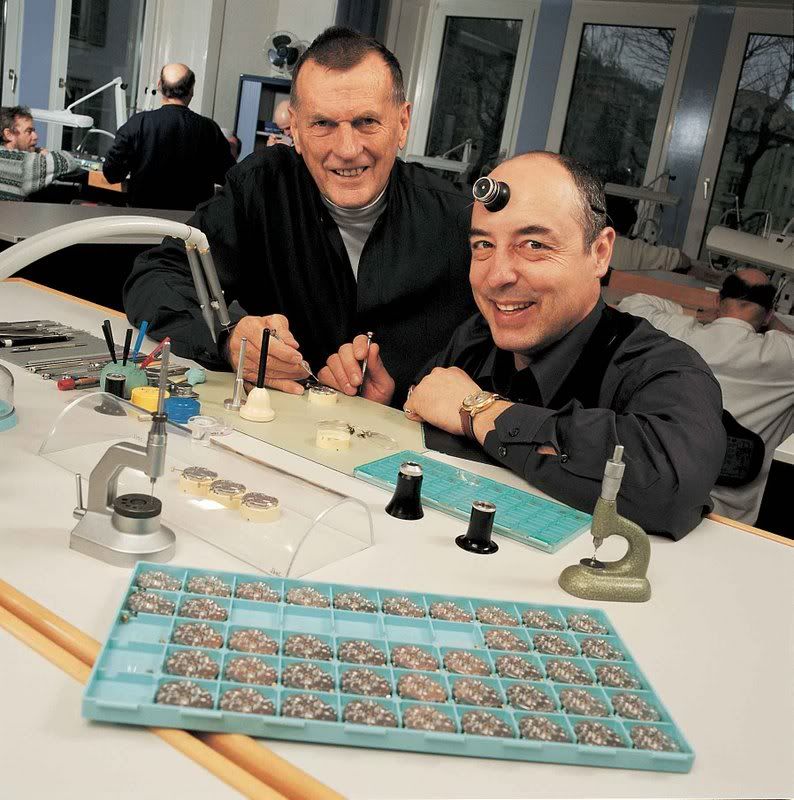 The men who created the first act of horological modern art, the incredible Rolf Schnyder and Ludwig Oechslin The Freak is an unerring, constant reminder to us that a mechanical wristwatch should be an expression of human creativity. This is important fore the following reason?. Since the beginning of civilization men crafted instrument to tell time. From the start he was chasing one thing. He stalked the elusive God called accuracy. He prevailed upon everything from sundials that used shadows to mark the passing of the day to astrolabes which told him time based on the position of stars relative to the horizon. But when man created the mechanical watch, the world?s first engine, his search for accuracy took a quantum leap. He began to harness and capture those fleeting moments of immortality. With the split second chronograph he could calculate lap times, with the perpetual calendar he could always tell the precise day, date, month, year and the position of the moon in the night sky. But in the 1970?s man found what he was looking for these many centuries. Through the oculus of his electron micro-scope he discovered the quartz engine a chip with circuits fed by electrical impulses. With it he achieved ultimate accuracy but also eliminated the need for human beings. The advent of the quartz era snuffed out the artist soul of the watchmaker. It robbed watchmaking of its humanity. Programmable chips replaced gears, lever, pinions and springs. But when all appeared lost, pockets of resistance to the quartz movement began to emerge led by men like Rolf W. Schnyder that saw that the beauty of the mechanical watch had never been in the accuracy it represented. Rather Schnyder realized that each mechanical watch beat an engine crafted through human labor that was endowed and born through human abilities. And it was this humanity that appealed to us because in each timepiece we saw a reflection of ourselves. With watches like the Astrolabium Galileo Galilei Schnyder reunited us with the human world of astrology, philosophy and reconnected us to our relationship with time. In 2001 with the Freak Schnyder reminded us that watchmaking is the merger of science and art. With the Freak he reminded us that science and art could live upon the same canvas. With the Freak Schnyder showed us that watches are art, that a beating escapement could fulfill us as completely as Yeats? perfect verses or a Kurosawa?s flawless celluloid images. The Freak reminds us that any watch is endowed with an innate poetry because of the human creativity it expresses. Together Rolf W. Schnyder and the Freak remind us that in the best possible sense any mechanical wristwatch, but in particular the Freak, is ?Poetry for the wrist.?
|
||||||||||||||
| |||||||||||||||
| Posted: Fri Sep 14th, 2007 11:01 pm |
|
2nd Post |
|
Skipdawg 3T WIS
|
I may be crazy but I like it! :cool: Yo Santa if feeling good about me.... :D
|
|||||||||||||
| ||||||||||||||
| Posted: Sat Sep 15th, 2007 12:03 pm |
|
3rd Post |
|
Paxman 3T WIS
|
My Hammy you had a busy Friday night!! What would be the cost of the Innovision if sold?? Beyond reality? These watches blur the line between horology and art in ways none have ever done before. Way over my double digit IQ!! I know the freak is O's ultimate dream watch so if we all pitch in we can get him one!!
|
||||||||||||||
| |||||||||||||||
| Posted: Sat Sep 15th, 2007 01:13 pm |
|
4th Post |
|
Hamilton 3T WIS
|
I would guess it would go for at least $100,000.00 and in extremely limited edtion. I'm sure Rolf owns one and certainly his closest friends own one too. Now, if I win the Mega this week I'll phone Rolf anf offer him $200,000.00 for the Innovision. Paxman wrote: My Hammy you had a busy Friday night!!
|
|||||||||||||
| ||||||||||||||
| Current time is 06:15 pm | |
| TimeTechTalk.com > Time Tech Talk > Time Talk > A closer look at the UN Freak...P.S Long Post... | Top |